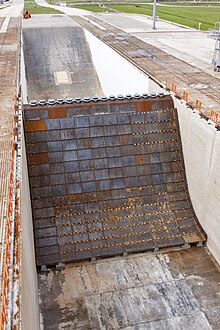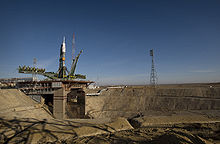Flame deflector

A flame deflector, flame diverter or flame trench is a structure or device designed to redirect or disperse the flame, heat, and exhaust gases produced by rocket engines or other propulsion systems.[2] The amount of thrust generated by a rocket launch, along with the sound it produces during liftoff, can damage the launchpad and service structure, as well as the launch vehicle.[3] The primary goal of the diverter is to prevent the flame from causing damage to equipment, infrastructure, or the surrounding environment. Flame diverters can be found at rocket launch sites and test stands where large volumes of exhaust gases are expelled during engine testing or vehicle launch.
Design and operation
The diverter typically comprises a robust, heat-resistant structure that channels the force of the exhaust gases and flames in a specific direction, typically away from the rocket or equipment. This is essential to prevent the potentially destructive effects of the high-temperature gases and to reduce the acoustic impact of the ignition.
A flame trench can also be used in combination with a diverter to form a trench-deflector system. The flames from the rocket travel through openings in the launchpad onto a flame deflector situated in the flame trench, which runs underneath the launch structure and extends well beyond the launchpad itself.[3] To further reduce the acoustic effects a water sound suppression system may be also used.
Notable examples
Apollo program
During the Apollo program the need for a flame deflector was a determining factor in the design of the Kennedy Space Center Launch Complex 39. NASA designers chose a two-way, wedge-type metal flame deflector. It measured 13 meters in height and 15 meters in width, with a total weight of 317 tons. Since the water table was close to the surface of the ground, the designers wanted the bottom of the flame trench at ground level. The flame deflector and trench determined the height and width of the octagonal shaped launch pad.[2]
Space Shuttle program

During the Space Shuttle program NASA modified Launch Complex 39B at Kennedy Space Center. They installed a flame trench that was 150 meters long, 18 meters wide, and 13 meters deep.[3] It was built with concrete and refractory brick. The main flame deflector was situated inside the trench directly underneath the rocket boosters. The V-shaped steel structure was covered with a high-temperature concrete material. It separated the exhaust of the orbiter main engines and of the solid rocket boosters into two flame trenches.[4][5] It was approximately 11.6 meters high, 17.5 meters wide, and 22 meters long.[3] The Shuttle flame trench-diverter system was refurbished for the SLS program.[4][6]
Baikonur Cosmodrome

The main launch pads at the Russian launch complex of Baikonur Cosmodrome use a flame pit to manage launch exhaust. The launch vehicles are transported by rail to the launch pad, where they are vertically erected over a large flame deflector pit.[7] A similar structure was built by the European Space Agency at its Guiana Space Centre.[7]
SpaceX Starship launch mount
During the first orbital test flight of SpaceX's Starship vehicle in April 2023, the launch mount of Starbase was substantially damaged due to the lack of a flame diverter system.[8] The 33 Raptor rocket engines dug a 25-foot-deep (7.6 m) crater and scattered debris and dust over a wide area.[8] The company designed a new water deluge based flame diverter that protects the launch mount and vehicle by spraying large quantities of water from a piece of steel equipment under the rocket.[9][8] In November of the same year, the new water deluge system successfully protected the launchpad during the second orbital flight test of Starship, avoiding the cloud of dust and debris that rose up during the first test.[10]
References
- ^ Herridge, Linda (2018-05-29). "Launch Pad 39B Flame Trench Nears Completion". NASA. Archived from the original on 2023-02-06. Retrieved 2023-09-01.
- ^ a b "Moonport, CH11-7". www.hq.nasa.gov. Archived from the original on 2023-09-01. Retrieved 2023-09-01.
- ^ a b c d Wessels, Wessel (2022-10-26). "The Purpose Of A Flame Trench At A Rocket Launch Site". Headed For Space. Archived from the original on 2023-09-01. Retrieved 2023-09-01.
- ^ a b "Deflecting the flames of a monster rocket". The Planetary Society. Archived from the original on 2023-09-01. Retrieved 2023-09-01.
- ^ Warnock, Lynda. "NASA - Flame Trench-Deflector System". www.nasa.gov. Archived from the original on 2022-11-28. Retrieved 2023-09-01.
- ^ Bergin, Chris (2016-05-08). "Renewing the famous Flame Trench, one brick at a time". NASASpaceFlight.com. Archived from the original on 2023-09-01. Retrieved 2023-09-01.
- ^ a b "Launcher". www.esa.int. Archived from the original on 2023-09-02. Retrieved 2023-09-02.
- ^ a b c "SpaceX Tests Starship Water Deluge System That It Should've Built in the First Place". Gizmodo. 2023-07-18. Archived from the original on 2023-09-01. Retrieved 2023-09-01.
- ^ Kolodny, Lora (2023-07-28). "SpaceX hasn't obtained environmental permits for 'flame deflector' system it's testing in Texas". CNBC. Archived from the original on 2023-10-07. Retrieved 2023-09-01.
- ^ Chang, Kenneth (2023-11-18). "SpaceX Makes Progress in 2nd Launch of Giant Moon and Mars Rocket". The New York Times. ISSN 0362-4331. Archived from the original on 2023-11-20. Retrieved 2023-11-20.
